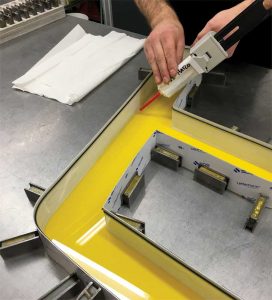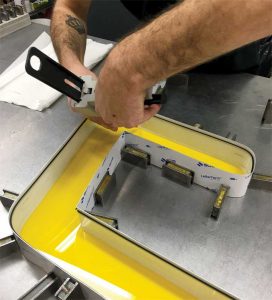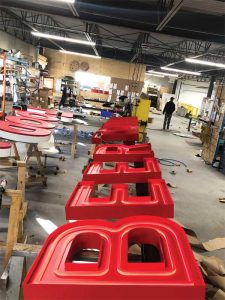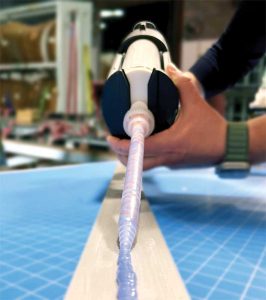Determining key signage sticking points
by carly_mchugh | 14 June 2023 4:50 pm
 [1]
[1]Signage is constantly exposed to ever-changing conditions and must be made with an adhesive flexible enough to keep up. Photos courtesy MPI Matco
By David Mucciarone
Signage is constantly exposed to ever-changing conditions. Therefore, it must be made with an adhesive that is flexible enough to keep up.
While durability and strength play important roles in the industry, they are only a fraction of the story. It is also crucial to consider how a sign’s environment can impact its esthetics, compliance, and visibility.
The adhesive is literally the glue that holds everything together. If it has strength, but not flexibility, it inevitably becomes the weakest link in the signage system. Imagine a bodybuilder attempting a routine on the parallel bars. It might sound cringeworthy, but this is the reality a sign could face if it is fabricated using the wrong adhesive.
Moving with the times
Signmakers understand the importance of adapting to market demands. They continuously optimize the effectiveness, capability, and relevance of their products.
Though common materials used for signage still include aluminum, acrylic, plastics, and galvanized metals, there are increasing expectations that have affected material selection. Greener, more environmentally friendly options have become deciding factors for many clients. Further, the rising costs of metals and aluminum have increased the demand for new, more lightweight signage materials, including aluminum composite material (ACM) panels. While these changes have dramatically reduced the thickness and cost of aluminum pieces, they have also increased the likelihood of damage to the signs made with these materials.
Lightweight signs are exposed to very different risks. These considerations are imperative when selecting an adhesive, as not all products are created equal. Knowing what types of adhesives work best with different materials will help reduce scraps, repairs, or costs in the long-term. Respecting quality standards is more than just esthetics. After all, well-made signage is all about form meeting function.
Mitigating wear and tear
Read-through and adhesive cracking are common problems seen in the sign industry, due to the materials typically used in signage applications.
Read-through occurs when there is distortion or visible marks on the substrate over a cured adhesive bond line. Adhesive cracking, also known as bond failure, is caused when the adhesive bond between the substrate and the sign face fails, causing the sign face to detach or fall off completely. This can result in damage to the sign and potentially create safety hazards.
 [2]
[2]Knowing what types of adhesives work best with different materials will help reduce scraps, repairs, or costs in the long-term.
Signage that is lightweight and easy to handle is often made up of thin substrates, such as plastic sheets or aluminum composites. These materials each have their own thermal expansion coefficient, which means they can expand or contract significantly with temperature changes. This can create stress at the bond line between the substrate and the adhesive, leading to read-through or adhesive cracking, often characterized by deformations, visible marks, or distortion.
If the adhesive used in the sign application lacks the flexibility to accommodate the thermal expansion, the problem worsens, and the adhesive may crack or break, leading to further substrate deformation and read-through.
Adhesives formulated to minimize the occurrence of read-through and adhesive cracking challenges typically have a low modulus, high flexibility, and low shrinkage. This helps minimize the stress and distortion of the substrates over the cured adhesive bond line during thermal expansion and contraction. These adhesives also have a low curing temperature, which is important for preventing thermal distortion of thin substrates, composites, and plastics.
By choosing the right adhesive for the job, signmakers can ensure their bonds are strong, durable, and long-lasting.
 [3]
[3]Material considerations are imperative when selecting an adhesive, as not all products are created equal.
What causes read-through?
Adhesives known to cause read-through are prone to a variety of issues, including shrinkage, high curing temperatures, and inadequate flexibility and environmental resistance.
Shrinkage
Adhesives can shrink as they cure. When they do, there is a pull on the substrate, which creates stress at the bond line and may cause it to deform. This is particularly true for adhesives that have high filler content or are formulated with solvents.
High curing temperatures
Some adhesives require high curing temperatures to achieve optimal bond strength. However, if the curing temperature is too high, it can cause the substrate to deform or warp. This is especially true for thin substrates, which are more sensitive to temperature changes.
Inadequate flexibility
Adhesives that are too rigid or have a high modulus are often unable to accommodate the thermal expansion and contraction of the substrate. This can create stress at the bond line and cause the substrate to deform or warp.
Inadequate environmental resistance
Adhesives that are not formulated to withstand environmental factors, such as ultraviolet (UV) exposure or moisture, can degrade or lose bond strength over time, leading to deformation of the substrate.
 [4]
[4]Well-made signage is all about form meeting function.
What causes adhesive cracking?
Adhesive cracking can also occur for several reasons, including stress, changes in temperature, and incompatible combinations of adhesives and substrates.
Excessive stress
If the substrate experiences excessive stress due to bending or twisting, it can cause the adhesive bond to fail.
Temperature changes
Dramatic changes in temperature can cause substrates—such as plastic sheets or aluminum composites—and their adhesives to expand and contract at different rates. This adds additional stress on the bond line, potentially causing the bond to fail.
Incompatible combinations
If the adhesive and substrate are not well-matched in terms of their thermomechanical properties, this can lead to bond failure.
The role of the environment
While signmakers cannot control the weather, they can control their choice of adhesives. The environment is another element that has a direct impact on adhesive cracking. Below are the top five harmful environmental factors known to cause this issue.
- Temperature changes: Rapid or extreme changes in temperature can cause the adhesive to expand or contract at a different rate than the substrate, creating stress, which can lead to cracking.
- UV exposure: Exposure to UV radiation from sunlight or other sources can cause the adhesive to degrade and lose its bond strength, which can eventually lead to cracking.
- Moisture: Exposure to moisture can cause the adhesive to swell or soften, which can lead to cracking under stress.
- Chemical exposure: Exposure to certain chemicals can cause the adhesive to break down or lose its bond strength, which can lead to cracking.
- Mechanical stress: Excessive mechanical stress on the bond, such as from impact or bending, can cause cracking in the adhesive.
 [5]
[5]By choosing the right adhesive, signmakers can ensure their bonds are strong, durable, and long-lasting.
Measuring stress under pressure
Some additional properties which can influence read-through are the thermal expansion coefficient, modulus of elasticity and yield strength, glass transition temperature, application, and fatigue resistance.
Coefficient of thermal expansion (CTE)
This measures how much a material expands or contracts as its temperature changes. Ensuring the CTE of the substrate is similar to that of the adhesive can help eliminate stress at the bond line and significantly reduce the chance of read-through.
Modulus of elasticity and yield strength
These define how stiff or rigid a material is and how far it can be stretched. The amount of stress a material can take before becoming permanently deformed is referred to as its yield strength. If either the modulus of elasticity or the yield strength of the adhesive is too low, it may not be able to hold the substrate in place and prevent read-through.
Glass transition temperature (Tg)
This is the temperature at which a material transitions from a rigid, glassy state to a softer, more flexible state. If the Tg of the adhesive is too high, it may not be able to accommodate the thermal expansion and contraction of the substrate, leading to stress and read-through.
Application
Proper application techniques are crucial, such as using the right type of adhesive, applying it evenly, and ensuring the substrate surface is properly cleaned and prepared. Curing temperature and humidity conditions during the application process also reduce the risk of read-through.
Fatigue resistance
This refers to the ability of signage to withstand repeated stress or strain without failure. Beware of fillers which can be added to provide initial elasticity, as they can degrade over time and lead to fatigue.
Gaining understanding, not product knowledge
It is important for signmakers to be clear on the specific requirements of their projects. They should also be concerned about product capabilities, especially when trying to avoid the need to troubleshoot an application. Indeed, adhesives come with their strengths and limitations, but collaborating with an expert will help signmakers understand their bonding application, environment, materials of choice, and other stressors.
Companies should first ask their adhesive supplier about durability elongation and modulus. It is crucial to remember impact resistance is a combination of having a low modulus and an adhesive that is able to support elongation. They should also inquire about how certain products are formulated to answer adhesive rigidity issues and request a meeting with an adhesives engineer to define any bonding challenges.
Conclusion
Signmakers should not feel as if they are stuck with the first adhesive supplier they meet. A solutions specialist should come with a proven track record, specialized product knowledge, and long-standing industry partnerships. When in doubt, it is best to assume strength without flexibility means signage with a shorter life expectancy.
David Mucciarone is the vice-president of MPI Matco, a provider of adhesive solutions for a variety of industries and applications, including signs and graphics.
- [Image]: https://www.signmedia.ca/wp-content/uploads/2023/08/mpimatco_1.jpg
- [Image]: https://www.signmedia.ca/wp-content/uploads/2023/08/mpimatco_7.jpg
- [Image]: https://www.signmedia.ca/wp-content/uploads/2023/08/mpimatco_6.jpg
- [Image]: https://www.signmedia.ca/wp-content/uploads/2023/08/mpimatco_2.jpg
- [Image]: https://www.signmedia.ca/wp-content/uploads/2023/08/mpimatco_10.jpg
Source URL: https://www.signmedia.ca/determining-key-signage-sticking-points/